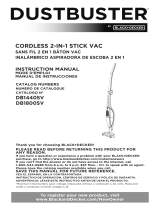
5
on, tripped over, or otherwise subjected to damage or stress.
• Do not use an extension cord unless it is absolutely
necessary. Use of improper extension cord could result in risk of
fire, electric shock, or electrocution.
• An extension cord must have adequate wire size (AWG or
American Wire Gauge) for safety. The smaller the gauge number
of the wire, the greater the capacity of the cable, that is 16 gauge
has more capacity than 18 gauge. When using more than one
extension to make up the total length, be sure each individual
extension contains at least the minimum wire size.
• Do not place any object on top of charger or place the
charger on a soft surface that might block the ventilation slots
and result in excessive internal heat. Place the charger in a
position away from any heat source. The charger is ventilated
through slots in the top and the sides of the housing.
• Do not mount charger on wall or permanently affix charger to
any surface. The charger is intended to use on a flat, stable
surface (i.e., table top, bench top).
• Do not operate charger with damaged cord or plug — have
them replaced immediately.
• Do not operate charger if it has received a sharp blow, been
dropped, or otherwise damaged in any way. Take it to an
authorized service center.
• Do not disassemble charger; take it to an authorized service
center when service or repair is required. Incorrect reassembly
may result in a risk of electric shock, electrocution or fire.
• Disconnect the charger from the outlet before attempting any
cleaning. This will reduce the risk of electric shock. Removing
the battery pack will not reduce this risk.
• NEVER attempt to connect 2 chargers together.
• The charger is designed to operate on standard household
electrical power (120 Volts). Do not attempt to use it on any
other voltage.
Important Safety Instructions for Battery
Chargers
SAVE THESE INSTRUCTIONS: This manual contains important safety
instructions for battery chargers.
• Before using charger, read all instructions and cautionary markings
on charger, battery pack, and product using battery pack.
WARNING: Shock hazard. Do not allow any liquid to
get inside charger.
CAUTION: Burn hazard. To reduce the risk of injury, charge only
Black & Decker batteries. Other types of batteries may burst causing
personal injury and damage.
CAUTION: Under certain conditions, with the charger plugged in to
the power supply, the charger can be shorted by foreign material.
Foreign materials of a conductive nature such as, but not limited to,
steel wool, aluminum foil, or any buildup of metallic particles should be
kept away from charger cavities. Always unplug the charger from the
power supply when there is no battery pack in the cavity. Unplug
charger before attempting to clean.
• The charger supplied with this product is intended to be
plugged in such that it is correctly orientated in a vertical or
floor mount position.
WARNING:
• DO NOT attempt to charge the battery pack with any
chargers other than the ones listed in this manual. The charger
and battery pack are specifically designed to work together.
• These chargers are not intended for any uses other than
charging Black&Decker rechargeable batteries. Any other uses
may result in risk of fire, electric shock or electrocution.
• Do not expose charger to rain or snow.
• Pull by plug rather than cord when disconnecting charger.
This will reduce risk of damage to electric plug and cord.
• Make sure that cord is located so that it will not be stepped













